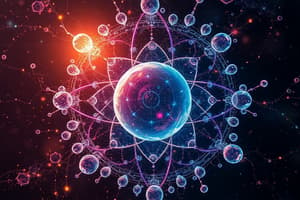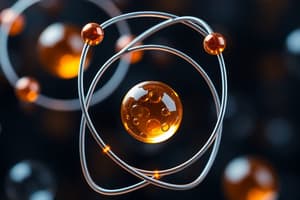Podcast
Questions and Answers
Which atomic model introduced the concept of the nucleus containing densely packed positive charges?
Which atomic model introduced the concept of the nucleus containing densely packed positive charges?
- Rutherford's Model (correct)
- Dalton's Model
- Thomson's Model
- Bohr Model
What distinguishes isotopes of the same element?
What distinguishes isotopes of the same element?
- Different numbers of protons
- Different numbers of neutrons (correct)
- Different atomic numbers
- Different electron configurations
Which principle states that no two electrons in an atom can have the same set of four quantum numbers?
Which principle states that no two electrons in an atom can have the same set of four quantum numbers?
- Octet Rule
- Pauli Exclusion Principle (correct)
- Aufbau Principle
- Hund's Rule
What is the charge and location of protons within an atom?
What is the charge and location of protons within an atom?
In an electron configuration, which subshell is filled first?
In an electron configuration, which subshell is filled first?
What kind of particle is formed when an atom loses electrons?
What kind of particle is formed when an atom loses electrons?
Which atomic model is characterized by electrons occupying probability clouds rather than fixed orbits?
Which atomic model is characterized by electrons occupying probability clouds rather than fixed orbits?
Which ions are formed by the gain of electrons?
Which ions are formed by the gain of electrons?
What is the basic unit that determines the atomic identity of an element?
What is the basic unit that determines the atomic identity of an element?
Which of the following best describes Thomson's Plum Pudding Model?
Which of the following best describes Thomson's Plum Pudding Model?
Flashcards are hidden until you start studying
Study Notes
Atomic Models
- Dalton's Model: Proposed the atom as indivisible and indestructible. Matter consists of atoms; different elements have different atoms.
- Thomson's Model (Plum Pudding Model): Suggested that atoms are composed of electrons (negative charges) scattered within a positively charged 'soup'.
- Rutherford's Model: Introduced the nucleus, showing atoms have a small, dense positive center (nucleus) with electrons orbiting around it.
- Bohr Model: Built on Rutherford’s model; proposed that electrons move in fixed orbits at specific distances from the nucleus, with quantized energy levels.
- Quantum Mechanical Model: Describes the behavior of electrons in probabilistic terms; electrons occupy clouds (orbitals) rather than fixed paths.
Subatomic Particles
- Protons:
- Positive charge (+1)
- Located in the nucleus
- Determines atomic number and identity of the element
- Neutrons:
- No charge (neutral)
- Located in the nucleus
- Contributes to atomic mass and stability of the nucleus
- Electrons:
- Negative charge (-1)
- Orbit around the nucleus in energy levels
- Involved in chemical bonding and reactions
Electron Configurations
- Describes the arrangement of electrons in an atom.
- Follows the Aufbau principle (electrons fill lowest energy orbitals first).
- Follows Pauli Exclusion Principle (no two electrons in an atom can have the same set of four quantum numbers).
- Follows Hund’s Rule (electrons will fill degenerate orbitals singly before pairing up).
- General Configuration Notation:
- Electron configurations are written in the format of subshells: e.g., 1s² 2s² 2p⁶ (for Neon).
- Valence electrons are important for determining chemical reactivity.
Isotopes And Ions
- Isotopes:
- Atoms of the same element with the same number of protons but different numbers of neutrons.
- Examples: Carbon-12, Carbon-14 (both have 6 protons but different neutrons).
- Impact on atomic mass and nuclear stability.
- Ions:
- Charged atoms formed by the loss or gain of electrons.
- Cations: Positively charged ions (loss of electrons).
- Example: Na⁺ (sodium ion).
- Anions: Negatively charged ions (gain of electrons).
- Example: Cl⁻ (chloride ion).
- Ions play crucial roles in chemical bonding and electrical conductivity.
Atomic Models
- Dalton's Model proposed that atoms were indivisible and indestructible.
- Thomson's Model, also known as the "Plum Pudding Model", suggested that atoms were composed of negatively charged electrons scattered within a positively charged "soup".
- Rutherford's Model introduced the concept of the nucleus, showing atoms have a small, dense, positively charged center with electrons orbiting around it.
- Bohr Model built upon Rutherford's model and proposed that electrons move in fixed orbits at specific distances from the nucleus, with quantized energy levels.
- Quantum Mechanical Model describes electrons in probabilistic terms, existing within clouds (orbitals) rather than fixed paths.
Subatomic Particles
- Protons are located in the nucleus and carry a positive charge. They determine the atomic number and therefore the identity of an element.
- Neutrons are also located in the nucleus and carry no charge. They contribute to the atomic mass and stability of the nucleus.
- Electrons carry a negative charge, orbit the nucleus in energy levels, and are responsible for chemical bonds and reactions.
Electron Configurations
- Electron configurations describe the arrangement of electrons within an atom.
- Electrons fill orbitals according to the Aufbau principle, filling the lowest energy orbitals first.
- The Pauli Exclusion Principle states that no two electrons in an atom can have the same set of four quantum numbers.
- Hund's Rule dictates that electrons will fill degenerate orbitals singly before pairing up.
- General Configuration Notation uses subshells to express electron configurations, like 1s² 2s² 2p⁶ for Neon.
- Valence electrons are the electrons in the outermost shell and are crucial in determining chemical reactivity.
Isotopes And Ions
- Isotopes are atoms of the same element with the same number of protons but different numbers of neutrons.
- Isotopes affect atomic mass and nuclear stability. For example, Carbon-12 and Carbon-14 both have 6 protons but different numbers of neutrons.
- Ions are charged atoms formed by the loss or gain of electrons.
- Cations are positively charged ions formed by the loss of electrons. For example, Na⁺ (sodium ion).
- Anions are negatively charged ions formed by the gain of electrons. For example, Cl⁻ (chloride ion).
- Ions are essential for chemical bonding and electrical conductivity.
Studying That Suits You
Use AI to generate personalized quizzes and flashcards to suit your learning preferences.



